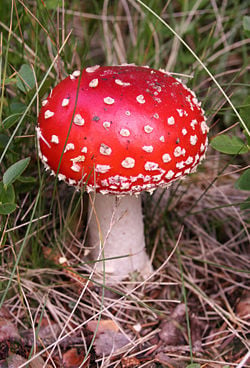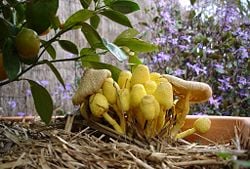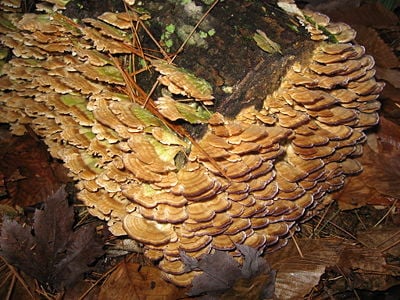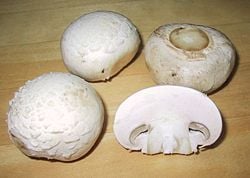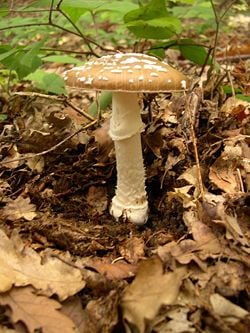Mushroom
A mushroom is the fleshy, spore-bearing fruiting body (sporocarp or reproductive structure) of a fungus, typically produced above ground on soil or on its food source. The term "mushroom" also is used to designate the entire fungus with a fruiting body.
While the term mushroom is often associated with fungi that have a stem (stipe or stalk), a cap (pileus), and gills (lamella, the papery ribs under the cap of a mushroom), the term can refer to a wide variety of gilled fungi with or without stems and more generally any fruiting body.
Mushrooms provide culinary, commercial, aesthetic, and ecological values. Since prehistoric times, people have consumed them. Edible varieties can be flavorful and provide B vitamins and minerals such as potassium, phosphorus, selenium, and iron; but mushrooms do not have many calories. Mushroom growing and sales have been an important industry, and the diverse forms and colors of mushrooms add to the wondrous nature for humans. Ecologically, various animals, such as rodents and birds, eat mushrooms, this makes mushrooms an important source of nutrition and energy in terrestrial food chains.
On the other hand, many species of mushrooms contain toxins that can cause human sickness or even death. Among the most deadly mushrooms are the destroying angel and the deathcap, members of the genus Amanita, which have killed many mushroom hunters.
Overview
A fungus is a eukaryotic organism that digests its food externally and absorbs nutrient molecules into its cells. Fungi make up one of the kingdoms into which living things are classified by biologists. Mushrooms are unique because they differ from bacteria, which do not have a cell nucleus; they are not a plant because mushrooms do not make their own food through photosynthesis; and they differ from animals because they are not mobile and do not absorb nutrition externally. Mushrooms are, however, related to other fungi organisms such as, yeasts, molds, and mildews.
Fungi may be single-celled or multi-cellular. Multi-cellular fungi are composed of networks of long hollow tubes called hyphae. The hyphae often gather in dense networks known as mycelium. The mycelium is the vegetative part of a fungus, and consists of the mass branching, thread-like hyphae. The mycelium grows through the medium on which the fungus feeds. Because most fungi are embedded in the medium in which they grow, most often soil, they are often not visible.
Although fungi lack true organs, the mycelia can become organized into more complex reproductive structures called fruiting bodies, or sporocarps, under the right conditions. The sporocarp or fruiting body is a multi-cellular structure in which spore-producing structures, such as basidia or asci, are borne. The fruiting body is part of the sexual phase of a fungal life cycle, the rest of the life cycle is characterized by its vegetative mycelial growth. The sporocarp of a basidiomycete (club fungi, one of the major divisions of fungi) is known as a basidiocarp, while the fruiting body of an ascomycete (sac fungi) is known as an ascocarp.
Mushroom is the common name given to the fruiting bodies of many fungal species. Although these typically above-ground structures are the most conspicuous to humans, they make up only a small portion of the entire fungal body.
The standard for the name "mushroom" is the cultivated white button mushroom, Agaricus bisporus, hence the word mushroom is most often applied to fungi (Basidiomycota, Agaricomycetes) that have a stem (stipe), a cap (pileus), and gills (lamellae, sing. lamella) on the underside of the cap just as do store-bought white mushrooms. Stipe refers to the stem or stalk-like feature supporting the cap of a mushroom. The pileus is the technical name for what is commonly known as the cap of a fungal fruiting body, which is often umbrella shaped, but may take many forms. A gill or lamella is one of the papery ribs under the cap of a mushroom.
However, "mushroom" can also refer to a wide variety of gilled fungi, with or without stems, and the term is used even more generally to describe both the fleshy fruiting bodies of some Ascomycota and the woody or leathery fruiting bodies of some Basidiomycota, depending upon the context of the word. Forms deviating from the standard form usually have more specific names, such as "puffball," "stinkhorn," and "morel," and gilled mushrooms themselves are often called "agarics" in reference to their similarity to Agaricus or their placement in the order Agaricales.
By extension, "mushroom" can also designate the entire fungus when in culture or the thallus (called a mycelium) of species that form the fruiting bodies called mushrooms.
Mushroom vs. toadstool
The terms "mushroom" and "toadstool" date back centuries and were never precisely defined, nor was there consensus on its application. There is no scientific distinction between these terms. The term "toadstool" has often but not exclusively been applied to poisonous or inedible mushrooms, but has also been applied to those mushrooms that are edible and have the classic umbrella-like cap-and-stem form.
Between 1400 and 1600 C.E., the terms tadstoles, frogstooles, frogge stoles, tadstooles, tode stoles, toodys hatte, paddockstool, puddockstool, paddocstol, toadstoole, and paddockstooles were sometimes used synonymously with mushrom, mushrum, muscheron, mousheroms, mussheron, or musserouns (Ramsbottom 1954). The term "mushroom" and its variations may have been derived from the French word mousseron in reference to moss (mousse). There may have been a direct connection to toads (in reference to poisonous properties) for toadstools.
However, there is no clear-cut delineation between edible and poisonous fungi, so that a "mushroom" technically may be edible, poisonous, or unpalatable. The term "toadstool" is currently used in storytelling when referring to poisonous or suspect mushrooms. The classic example of a toadstool is Amanita muscaria.
Growth rates
Many species of mushrooms seemingly appear overnight, growing or expanding rapidly. This phenomenon is the source of several common expressions in the English language, including "to mushroom" or "mushrooming" (expanding rapidly in size or scope) and "to pop up like a mushroom" (to appear unexpectedly and quickly). In actuality, all species of mushrooms take several days to form primordial mushroom fruiting bodies, though they do expand rapidly by the absorption of fluids.
The cultivated mushroom as well as the common field mushroom initially form a minute fruiting body, referred to as the pin stage because of their small size. Slightly expanded, they are called buttons, once again because of the relative size and shape. Once such stages are formed, the mushroom can rapidly pull in water from its mycelium and expand, mainly by inflating preformed cells that took several days to form in the primordia.
Similarly, there are even more ephemeral mushrooms, like Parasola plicatilis (formerly Coprinus plicatlis), that literally appear overnight and may disappear by late afternoon on a hot day after rainfall. The primordia form at ground level in lawns in humid spaces under the thatch and after heavy rainfall or in dewy conditions balloon to full size in a few hours, release spores, and then collapse. They "mushroom" to full size.
The slang term "mushrooms" has served as a gang-related term for victims accidentally shot as collateral damage simply because they popped up suddenly, as do fungal mushrooms (Sherman et al. 1989).
Not all mushrooms expand overnight; some grow very slowly and add tissue to their fruiting bodies by growing from the edges of the colony or by inserting hyphae.
Identification
Identifying mushrooms requires a basic understanding of their macroscopic structure. Most are Basidiomycetes and gilled. Their spores, called basidiospores, are produced on the gills and fall in a fine rain of powder from under the caps as a result. At the microscopic level, the basidiospores are shot off of basidia and then fall between the gills in the dead air space. As a result, for most mushrooms, if the cap is cut off and placed gill-side-down overnight, a powdery impression reflecting the shape of the gills (or pores, or spines, etc.) is formed (when the fruiting body is sporulating). The color of the powdery print, called a spore print, is used to help classify mushrooms and can help to identify them. Spore print colors include white (most common), brown, black, purple-brown, pink, yellow, and cream, but almost never blue, green, or red.
While modern scientific identification of mushrooms is quickly becoming molecular, the standard methods for identification are still used by most and have developed into a fine art harking back to medieval times and the Victorian era. This ancient art is combined with microscopic examination. The presence of juices upon breaking, bruising reactions, odors, tastes, shades of color, habitat, habit, and season are all considered by mycologists, amateur and professional alike. Tasting and smelling mushrooms carries its own hazards because of poisons and allergens. Chemical spot tests are also used for some genera.
In general, identification to genus can often be accomplished in the field using a local mushroom guide. Identification to species, however, requires more effort; one must remember that a mushroom develops from a button stage into a mature structure, and only the latter can provide certain characteristics needed for the identification of the species. However, over-mature specimens lose features and cease producing spores. Many novices have mistaken humid water marks on paper for white spore prints, or discolored paper from oozing liquids on lamella edges for colored spore prints.
Classification
Two of the five major divisions (phyla) of fungi (Kingdom Fungi) are the Ascomycota and the Basidiomycota. The Ascomycota, commonly known as sac fungi or ascomycetes, form meiotic spores called ascospores, which are enclosed in a special sac-like structure called an ascus. This division includes morels, some mushrooms and truffles, as well as single-celled yeasts and many species that have only been observed undergoing asexual reproduction. Members of the Basidiomycota, commonly known as the club fungi or basidiomycetes, produce meiospores called basidiospores on club-like stalks called basidia. Most common mushrooms belong to this group, as well as rust and smut fungi, which are major pathogens of grains.
Typical mushrooms are the fruiting bodies of members of the order Agaricales, whose type genus is Agaricus and type species is the field mushroom, Agaricus campestris. The order Agaricales is placed in the class Agariomycetes of the phylum Basidiomycota. Agaricales is commonly known as the "gilled mushrooms."
However, in modern molecularly defined classifications, not all members of the order Agaricales have gills or produce mushroom fruiting bodies. Furthermore, many other gilled fungi, collectively called mushrooms, occur in other orders in the class Agaricomycetes. For example, chanterelles are in the Cantharellales, false chanterelles like Gomphus are in the Gomphales, milk mushrooms (Lactarius) and russulas (Russula) as well as Lentinellus are in the Russulales, while the tough leathery genera Lentinus and Panus are among the Polyporales, but Neolentinus is in the Gloeophyllales, and the little pin-mushroom genus, Rickenella, along with similar genera, are in the Hymenochaetales.
Within the main body of mushrooms, in the order Agaricales, are common fungi like the common fairy-ring mushroom (Marasmius oreades), shiitake, enoki, oyster mushrooms, fly agarics, and other amanitas, magic mushrooms like species of Psilocybe, paddy straw mushrooms, shaggy manes, and so forth.
An atypical mushroom is the lobster mushroom (Hypomyces lactifluorum), which is an ascomycete that parasitizes other mushrooms, such as the Russula or Lactarius. This may result in a deformed, cooked-lobster-colored outside from the lobster mushroom and the white flesh of the parasitized basidiomycete muchroom on the inside (Volk 2001).
Other mushrooms (those with fruiting bodies) are non-gilled. Some have pores underneath (and are usually called boletes), others have spines, such as the hedgehog mushroom and other tooth fungi, and so on. "Mushroom" has been used for polypores, puffballs, jelly fungi, coral fungi, bracket fungi, stinkhorns, and cup fungi.
Thus the term mushroom has more than one common application to macroscopic fungal fruiting bodies and associated organisms than one having precise taxonomic meaning. According to Chang and Miles (2004), there are approximately fourteen thousand described species of mushrooms.
Human use
Edible mushrooms
Edible mushrooms are used extensively in cooking, in many cuisines (notably Chinese, European, and Japanese). Though mushrooms are commonly thought to have little nutritional value, many species are high in fiber and provide vitamins such as thiamine (B1), riboflavin (B2), niacin (B3), biotin (B7), cobalamins (B12), and ascorbic acid (C), as well as minerals, including iron, selenium, potassium, and phosphorus. Mushrooms have been gaining a higher profile for containing the antioxidants ergothioneine and selenium.
Most mushrooms that are sold in supermarkets have been commercially grown on mushroom farms. The most popular of these, Agaricus bisporus, is safe for most people to eat because it is grown in controlled, sterilized environments, though some individuals do not tolerate it well. Several varieties of A. bisporus are grown commercially, including whites, crimini, and portabello. Other cultivated species now available at many grocers include shiitake, maitake or hen-of-the-woods, oyster, and enoki.
People who collect mushrooms for consumption are known as mycophagists, and the act of collecting them for such is known as mushroom hunting, or simply "mushrooming."
Toxic mushrooms
Of central interest is the chemical properties of mushrooms and the fact that many species produce secondary metabolites that render them toxic, mind-altering, or even bioluminescent.
There are a number of species of mushroom that are poisonous, and although some resemble certain edible species, eating them could be fatal. Eating mushrooms gathered in the wild is risky and should not be undertaken by individuals unknowledgeable in mushroom identification, unless the individuals limit themselves to a small number of good edible species that are visually distinctive. More generally, and particularly with gilled mushrooms, separating edible from poisonous species requires meticulous attention to detail; there is no single trait by which all toxic mushrooms can be identified, nor one by which all edible mushrooms can be identified.
Though there are only a small number of deadly species, several have particularly severe and unpleasant symptoms. Toxicity likely plays a role in protecting the function of the basidiocarp: The mycelium has expended considerable energy and protoplasmic material to develop a structure to efficiently distribute its spores. One defense against consumption and premature destruction is the evolution of chemicals that render the mushroom inedible, either causing the consumer to vomit (see emetics) the meal or avoid consumption altogether.
Psychoactive mushrooms
Psilocybin mushrooms possess psychedelic properties. They are commonly known as "magic mushrooms" or "shrooms" and are available in many parts of the world, though a number of countries have outlawed their sale. Some mushrooms are eaten for their psychoactive effects, such as fly agaric, which is used for shamanic purposes by tribes in northeast Siberia. They have also been used in the West to enhance religious experiences. Because of their psychoactive properties, some mushrooms have played a role in native medicine, where they have been used to effect mental and physical healing, and to facilitate visionary states. One such ritual is the Velada ceremony. A representative figure of traditional mushroom use is the shaman and curandera (priest-healer) María Sabina.
As with many psychoactive substances, the effects of psychedelic mushrooms are subjective and unpredictable, with the effect ranging from exhilarating to distressing.
Medicinal mushrooms
Currently, many species of mushrooms and fungi used in thousand-year-old folk medicine practices are under intense study by ethnobotanists and medical researchers. Maitake, shiitake, chaga, and reishi are prominent among those being researched for their potential anti-cancer, anti-viral, or immunity-enhancing properties. Psilocybin, originally an extract of certain psychedelic mushrooms, is being studied for its ability to help people suffering from mental disease, such as obsessive-compulsive disorder. Minute amounts have been reported to stop cluster and migraine headaches (Sewell et al. 2006).
Other uses
Mushrooms can be used for dyeing wool and other natural fibers. The chromophores of mushrooms are organic compounds that produce strong and vivid colors, and all colors of the spectrum can be achieved with mushroom dyes. Before the invention of synthetic dyes, mushrooms were the primary source of textile dyes. This technique has survived in Finland, and many Middle Ages re-enactors have revived the skill.
Some fungi, types of polypores loosely called mushrooms, have been used as fire starters (known as tinder fungi). Ötzi the Iceman (a well-preserved natural mummy of a man from about 3300 B.C.E.) was found carrying such fungi. Mushrooms and other fungi will likely play an increasingly important role in the development of effective biological remediation and filtration technologies.
ReferencesISBN links support NWE through referral fees
- Arora, David. 1991. All That The Rain Promises and More: A Hip Pocket Guide to Western mushrooms. Berkeley: Ten Speed Press. ISBN 0898153883
- Bessette, A., A. R. Bessette, and D. W. Fischer. 1997. Mushrooms of Northeastern North America. Syracuse, NY: Syracuse University Press. ISBN 0815603886.
- Chang, S. T., and P. G. Miles. 2004. Mushrooms: Cultivation, Nutritional Value, Medicinal Effect, and Environmental Impact. Boca Raton, FL: CRC Press. ISBN 0849310431.
- Fischer, D. W., and A. Bessette. 1992. Edible Wild Mushrooms of North America: A Field-to-Kitchen Guide. Austin: University of Texas Press. ISBN 0292720793.
- Ramsbottom. J. 1954. Mushrooms & Toadstools. A study of the Activities of Fungi. London: Collins. OCLC 657799.
- Sewell, R. A., J. H. Halpern, and G. P. Harrison. 2006. Response of cluster headache to psilocybin and LSD. Neurology 66: 1920-1922. Retrieved December 11, 2007.
- Sherman, L. W., et al. 1989. Stray bullets and “mushrooms”: Random shootings of bystanders in four cities, 1977–1988. J. Quantitative Criminology 5(4): 297-316.
- Stamets, P. 2000. Growing Gourmet and Medicinal Mushrooms [Shokuyō oyobi yakuyō kinoko no saibai]. Berkeley, CA: Ten Speed Press. ISBN 1580081754.
- Stamets, Paul, and J. S. Chilton. 1983. Mushroom Cultivator: A Practical Guide to Growing Mushrooms at Home. Olympia, WA: Agarikon Press. ISBN 0961079800
- Volk, T. 2001. botit.botany.wisc.edu The lobster mushroom. University of Wisconsin-La Crosse. Retrieved December 11, 2007.
External links
All links retrieved November 10, 2022.
- David Fischer's American Mushrooms.
- Mushroom Expert.
- Mushroom Observer
- North American Mycological Association.
- International Society for Mushroom Science.
Credits
New World Encyclopedia writers and editors rewrote and completed the Wikipedia article in accordance with New World Encyclopedia standards. This article abides by terms of the Creative Commons CC-by-sa 3.0 License (CC-by-sa), which may be used and disseminated with proper attribution. Credit is due under the terms of this license that can reference both the New World Encyclopedia contributors and the selfless volunteer contributors of the Wikimedia Foundation. To cite this article click here for a list of acceptable citing formats.The history of earlier contributions by wikipedians is accessible to researchers here:
The history of this article since it was imported to New World Encyclopedia:
Note: Some restrictions may apply to use of individual images which are separately licensed.
